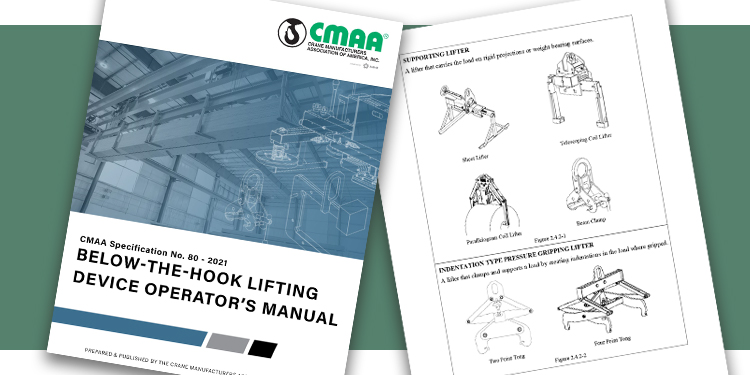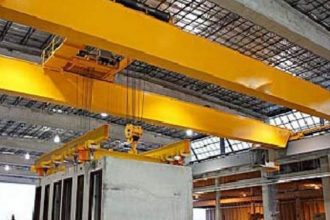
To enhance safety in facilities utilizing overhead traveling cranes in conjunction with below-the-hook lifting devices, the Crane Manufacturers Association of America (CMAA) has developed a new publication: CMAA Specification 80 – Below-The-Hook Lifting Device Operator’s Manual. The document is recommended for use as a complement to CMAA Specification 79 – Crane Operator’s Manual, as well as in conjunction with the operating instructions and maintenance manuals provided by the equipment manufacturer(s).
The new specification’s contents include definitions of safety alert symbols and placards, including those indicating “danger,” “warning,” “caution,” and “notice.” It also offers illustrations of the most commonly used below-the-hook lifting devices, which are specially designed to be the interface between a specific type of load and the hoist and overhead crane that will lift and transport it. Examples include structural lifters with a static, rigid structure for supporting a load, including 2- and 4-point lifting beams, C-hooks, and pallet lifters.
Also illustrated are an array of mechanical lifters that are powered manually, electrically, pneumatically or hydraulically to move two or more rigid components that connect to the load. These include:
- Supporting lifters that carry a load on rigid projections or weight bearing surfaces, including sheet lifters, telescoping coil lifters, parallelogram coil lifters, and beam clamps.
- Indentation-type pressure gripping lifters that clamp and support a load by creating indentations in the load where gripped, including 2- and 4-point tongs.
- Friction-type pressure gripping lifters that clamp and support a load by friction only, without causing significant deformation or indentation in the load where gripped, such as vertical coil lifters, plate clamps, and block lifters.
- Vacuum lifters that utilize a vacuum drawn through one or more pads to hold a load.
- Lifting magnets that are either remotely operated by personnel at a distance, or manually positioned and guided while in close proximity to the load.
- Grapple lifters that use multiple, opposing tines to clamp and lift bulk materials, such as scrap.
- Manipulating lifters that rotate the load about one or more axes during the lifting process, including rotating strap lifters and drum lifters.
Further, the specification details the types of sensors and warning indicators that an operator may encounter on a below-the-hook lifting device. It highlights the importance of performing equipment inspections at regular intervals, including prior to every lift, to assess the integrity of the device.
It also explains the need for more in-depth inspections to be performed in accordance with the requirements of ASMEB30.20, OSHA, the company that owns the equipment, and the device manufacturer. Inspection frequency is determined by the type of lifter, severity of use, and environmental conditions specific to the application. The specification also makes recommendations for the establishment of a preventative maintenance program and how to ensure repairs are performed properly.
Operators are provided with detailed guidance for how to properly handle, control, move, raise and lower a loaded lifting device; CMAA 80 should not be considered a substitute for the manufacturer’s instructions and maintenance manuals. A list of “shall” and “shall not” operator responsibilities is also included.
CMAA members represent the industry’s leading suppliers of overhead crane systems. They design, manufacture, assemble, install and service overhead cranes and components. CMAA members, with the combined experience of more than 30,000 crane installations in North America in the last decade, are committed to providing products which focus on safety and innovation. The organization offers a variety of resources — including buyers’ guides, engineering specifications, OSHA Alliance safety tip and fact sheets, inspection and maintenance checklists, safety seminars and more — via its website at www.MHI.org/CMAA.
Want to purchase the latest CMAA Specifications? The full technical specifications library — including the new document — is available now.



